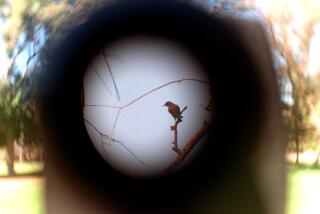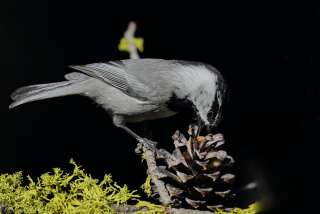Birders Track ‘Vagrant’ Hummingbirds
ALBANY, N.Y. — Chickadees, cardinals and titmice are common visitors to a snowy bird feeder. But hummingbirds?
That’s what Janet Allen saw last year in her yard in suburban Syracuse. For several days in dreary November, a young ruby-throated hummingbird shivered on a snow-laced feeder, sipping sugar water when it should have been flitting among tropical blossoms in sunny Mexico.
“It was kind of sad, really,” Allen said. “I don’t know if he got blown off course during migration or what. I assume he didn’t survive.”
A hummingbird spotted up north in the winter is an example of what birders and ornithologists call a “vagrant” -- a bird outside its normal range, or in its range in the wrong season.
Scientists at Cornell University’s Lab of Ornithology are asking a nationwide network of volunteers to be on the lookout for such birds this winter.
In recent years, observers all over the country have reported seeing various species of hummingbirds far from their normal range.
Licensed hummingbird bander Stacy Jon Peterson of Mountain Home, Idaho, has maintained a website that tallies and maps winter and out-of-normal-range hummingbird sightings since 1999. He said he gets more than 1,000 reports a year of rufous hummingbirds, a Northwestern species, spotted in Eastern states after Nov. 15, when they should be in Mexico.
It’s not known whether the birds are changing their range or if people are just becoming more aware of them.
“That’s why it’s important to monitor populations through long-term surveys like FeederWatch and the Audubon Society’s Christmas Bird Count -- so we’ll be able to answer questions like this in the future,” said David Bonter, director of Cornell’s Project FeederWatch, which enlists thousands of volunteers to submit reports on birds at their feeders. “Unfortunately, we don’t have good historical data on winter hummingbird sightings.”
Bird counts submitted by volunteers have also challenged the conventional wisdom about other birds in winter. Bluebirds and robins were a sure sign of spring in the Northeast until FeederWatch confirmed sightings of both in every month of the year throughout New England, Bonter said.
Data from FeederWatch’s 15,000 volunteers also documented recent shifts in distribution of birds in the West, possibly in response to forest fires, he said.
Researchers found that pinyon jays visited feeders more often than normal after wildfires swept through their preferred habitats. And counts of white-crowned sparrows dropped to a 16-year low in California last winter in areas hit by the worst fire season in state history.
Changes in the natural range of some species is well-documented. Carolina wrens and tufted titmice were seen infrequently in the Northeast 20 years ago, Bonter said, but now are common.
Bill Hilton Jr., a naturalist and hummingbird researcher in York, S.C., said the number of winter sightings of hummingbirds east of the Rocky Mountains has increased dramatically over the past decade -- mostly in the Southeast, but as far north as New York, Maine and Canada.
In addition, more than a dozen species of hummingbirds are being seen in the Southeast. Historically, the ruby-throated hummingbird has been the only species found east of the Mississippi.
“The vast majority of winter hummingbirds in the East are rufous,” Hilton said. The species breeds in the Northwest, as far north as Alaska, and normally winters in central Mexico. Hilton believes that the growing number of rufous hummingbirds in the East is partly due to winter habitat destruction, but he said other factors may be involved.
Birders traditionally take down hummingbird feeders by October, but Hilton said more people are leaving them up all winter to feed vagrants. They keep the liquid feeders from freezing by changing them several times a day or rigging up heat lamps or cables.
The opportunity to contribute to scientific research is one of the reasons that volunteers participate in FeederWatch.
“When I read about the citizen science projects, I thought it would be a great way to watch birds and contribute toward part of a large research project,” said Joanne Beckmann of suburban Albany, who is in her third season as a FeederWatcher.
Some people fear that putting out feeders will tempt hummingbirds to forgo migration and risk freezing. But Peterson and Hilton say that’s not true.
“On the contrary, finding feeders may be the only way these stragglers can survive,” Peterson said.
Allen, in suburban Syracuse, assumed her November hummer succumbed to the cold when it stopped showing up. But Peterson said it may have moved southward.
“Hummingbirds can enter torpor, a short hibernation, to survive cold nights,” he said. But he concedes that hanging around frigid Upstate New York in winter isn’t a good survival strategy.
“Unfortunately, people have discovered hummingbirds frozen to death under feeders.”
On the Net:
Project FeederWatch: https://birds.cornell.edu/pfw/
Winter hummingbird maps: https://www.trochilids.com
Operation RubyThroat: https://www.rubythroat.org/
More to Read
Sign up for The Wild
We’ll help you find the best places to hike, bike and run, as well as the perfect silent spots for meditation and yoga.
You may occasionally receive promotional content from the Los Angeles Times.






